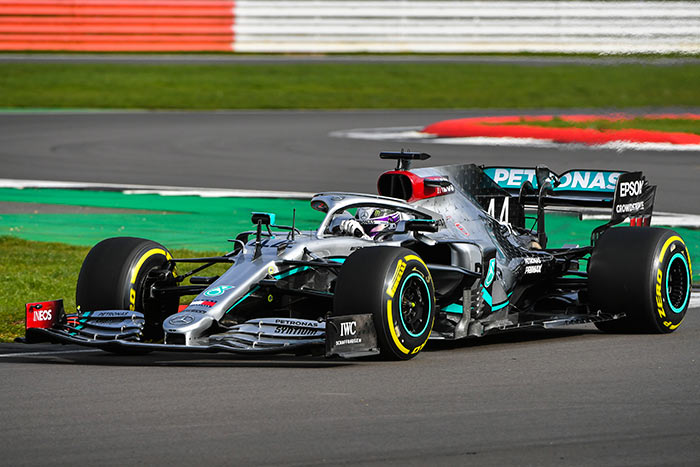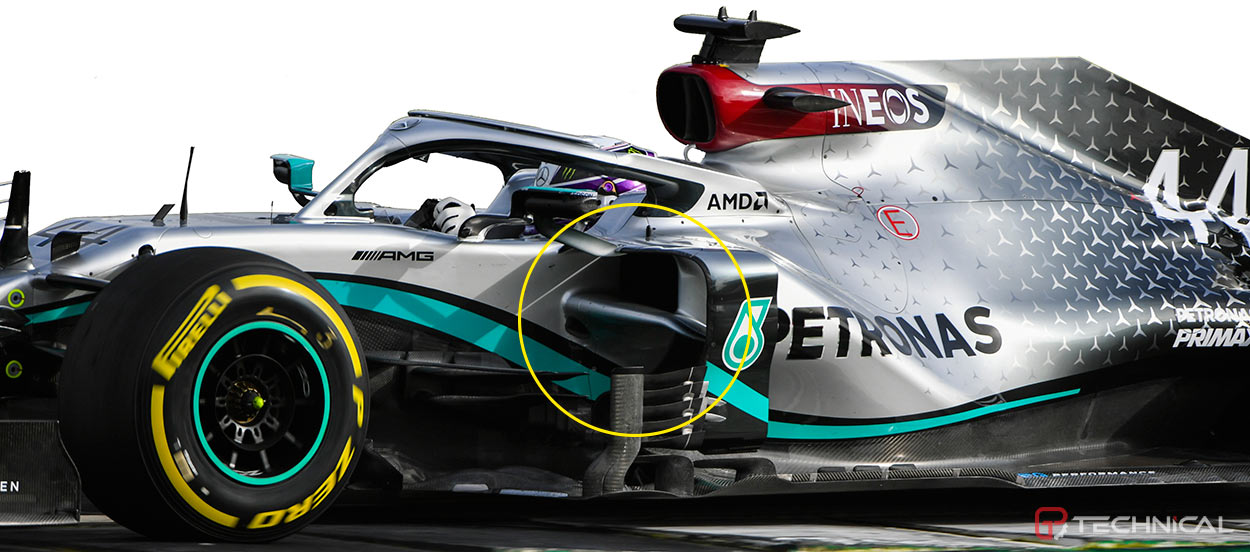Mercedes AMG F1 W11 EQ Performance

Active: 2020
Team: Mercedes AMG F1
Team: Toto Wolff (Executive Director), James Allison (Technical Director), Andy Cowell (Executive Director of Mercedes AMG Powertrains), Aldo Costa (Technical advisor), Mike Elliot (Technology Director), Mark Ellis (PD), Geoffrey Willis (Director of Digital Engineering Transformation), Ron Meadows (SD), Andrew Shovlin (Trackside Engineering Director), Simon Cole (CTE), Matthew Deane (CM), Loic Serra (HVD), John Owen (CD), Ashley Way (DCD), Rob Thomas (COO), Loic Serra (Performance Director), Jarrod Murphy (HA), Eric Blandin (CA)
Drivers: Lewis Hamilton (44), Valtteri Bottas (77), Stoffel Vandoorne (reserve), Esteban Gutierrez (reserve)
Team name: Mercedes AMG F1 Petronas
Major partners: Petronas, Ineos, UBS, Epson, Bose, Tommy Hilfiger, IWS Schaffhausen, Hewlet Packard, Pure Storage, Crowdstrike, Tibco, AMD
With 2020 having the same set of regulations as 2019, Mercedes were strongly positioned, given they ended the 2019 season with a really strong car. However tempting it might have been to just develop what they had, the team still opted for some serious progress, due to "feeling the breath of their competitors on their shoulders", as Technical Director James Allison described it.
At the front, the team changed "a lot of the front structures, and made it much much harder to cope with the cornering forces by accepting more complexity around the uprights and wheel rims. We've changed the detail inside the wheels, and in the way the suspension goes into the wheels so that we have more aerodynamic opportunity in the front end. It was difficult project, but one that has given us good aerodynamic gains".
Not commented on by the team, but discovered on the second day of testing at Barcelona, was the team's novel Dual Axis Steering (DAS) system, which allowed drivers to push and pull the steering wheel to alter the suspension settings. The team revealed it was the result of more than a year of development.
The largest obvious change in the middle part of the car is the lowering of the side impact structure. After most teams already adopted this design in the years before, Mercedes finally switched from the traditional high impact structure incorporated into the sidepod body towards a lower position, leaving more aerodynamic scope for development front of the sidepods, and the air inlet that now sits above and behind the impact structure.

The rear suspension was changed as well, with a new geometry for the lower wishbones specifically. Both lower wishbones have as such been moved forward, and closer together, giving the team "more scope for aerodynamic development, and downforce generation by the diffuser".
Allison also stated that these major changes on the car all meant adding extra weight, which was then offset by reducing the weight of tens of other existing and revised components.
Engine updates
On the engine front, the M11 power unit was again dubbed 'all new', although it was admitted to be an evolution of the 2019 version. While James Allison said that the people at Brixworth had found another 'impressive amount of new horsepower", chief of engines Andy Cowel said "We have worked on a huge array of projects, and when summed together they will hopefully help propel the car around the track quicker and give the aerodynamics team more opportunities to improve as well."
After struggles with the W10 in hot ambient temperatures, team members in both Brackley and Brixworth have worked together to improve the cooling package for the W11. In addition to larger radiators in the car, the team has focused on making the cooling more efficient by proving out higher operating temperatures for the engine.
"We are putting significant effort into making sure that all the cooling fluids on the Power Unit operate at a higher temperature,” said Andy. “This increases the temperature difference between that coolant fluid and the ambient temperature that we are racing in, which increases the effectiveness of the cooling system. That’s a tough challenge though, because large parts of the engine are made from aluminium and the temperatures that we are operating at mean the material properties are decaying quite rapidly. Managing that over an eight-race distance Power Unit cycle is a tough engineering challenge but that’s what we are striving for. As Power Unit engineers we don’t just focus on crankshaft power, we also focus a tremendous amount on the packaging and reducing the overheads for the aerodynamicist, so that they can mainly focus on keeping the car planted through the corner."
On-track performance
Mercedes debuted in 2020 Formula One car at the 2.98km version of Silverstone Circuit, on 14 February for a shakedown, with Valtteri Bottas driving in the morning, and Lewis Hamilton doing some laps in the afternoon. After that, the team transported its car off to Spain, where testing began on 19 February at Circuit de Catalunya near Barcelona.
The first week of testing was immediately a strong outing for Mercedes with its car completing the most mileage and topping the times in the end. Trouble began after that however, with engine reliability woes popping up in the next pre-season test. Mercedes would later admit they were lucky the start of the 2020 season was postponed as it allowed them to resolve the engine problems before the start of the season.
The 2020 season was disrupted due to the COVID-19 pandemic and started with the Austrian Grand Prix on 5 July, 3 months after the usual start of the season. There, the car proved strong with a 1-2 in qualifying and Bottas taking the win. The success story went on throughout the year with only three of the 17 races not won by the W11.
Specifications
Monocoque: Moulded carbon fibre and honeycomb composite structure
Bodywork: Carbon fibre composite including engine cover, sidepods, floor, nose, front wing and rear wing
Cockpit: Removable driver’s seat made of anatomically formed carbon composite, OMP six-point driver safety harness, HANS system
Safety structures: Cockpit survival cell incorporating impact resistant construction and penetration panels, front impact structure, prescribed side impact structures, integrated rear impact structure, front and rear roll structures, titanium driver protection structure (halo)
Front Suspension: Carbon fibre wishbone and pushrod activated torsion springs and rockers
Rear Suspension: Carbon fibre wishbone and pullrod activated torsion springs and rockers
Dampers: Penske (unconfirmed)
Wheels: OZ, forged magnesium
Tyres: Pirelli
Brake system: Carbon / carbon discs and pads (by Carbone industries) with rear brake-by-wire
Brake calipers: Brembo
Steering: Power assisted rack and pinion
Electronics: FIA standard ECU and FIA homologated electronic and electrical system
Instrumentation: McLaren Electronic Systems (MES)
Fuel system: ATL Kevlar-reinforced rubber bladder
Transmission
Gearbox: Eight-speed forward, one reverse unit with carbon fibre maincase
Gear selection: Sequential, semi-automatic, hydraulic activation
Clutch: Carbon plate
Dimensions
Overall length: over 5000mm
Overall width: 2000mm
Overall height: 950mm
Overall weight: 746 kg (including driver and camera, excluding fuel)
Powertrain
Designation: Mercedes-AMG F1 M11 EQ Performance
Type: Turbocharged, 90° 1.6l V6, assisted with kinetic and heat ERS
No of valves: 24 (4 per cylinder)
Fuel injection: High-pressure direct injection (max 500 bar, one injector/cylinder)
Pressure charging: Single-stage compressor and exhaust turbine on a common shaft
Bore: 80mm
Stroke: 53mm
Crank height: 90mm (minimum allowed)
Energy recovery system: Integrated Hybrid energy recovery via electrical Motor Generator Units
Energy Store: Lithium-Ion battery solution, between 20 and 25 kg
Fuel: PETRONAS Primax
Lubricants: PETRONAS Syntium
Gearbox & hydraulic oil: PETRONAS Tutela
Power: In excess of 950bhp





